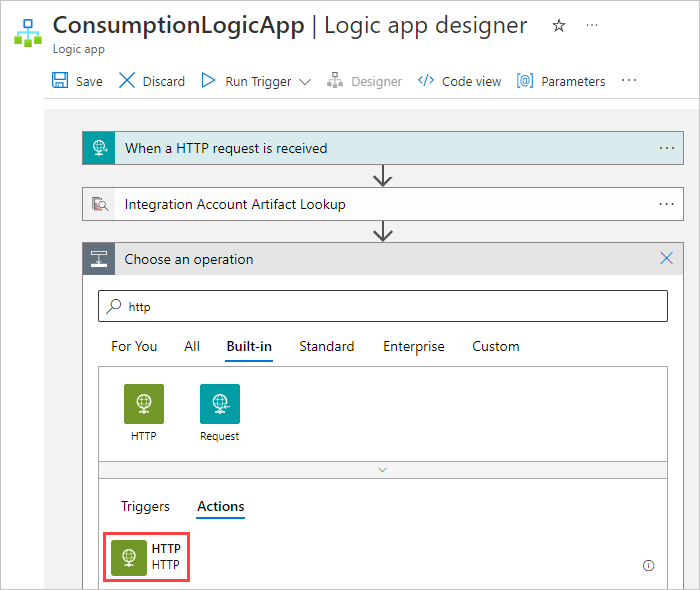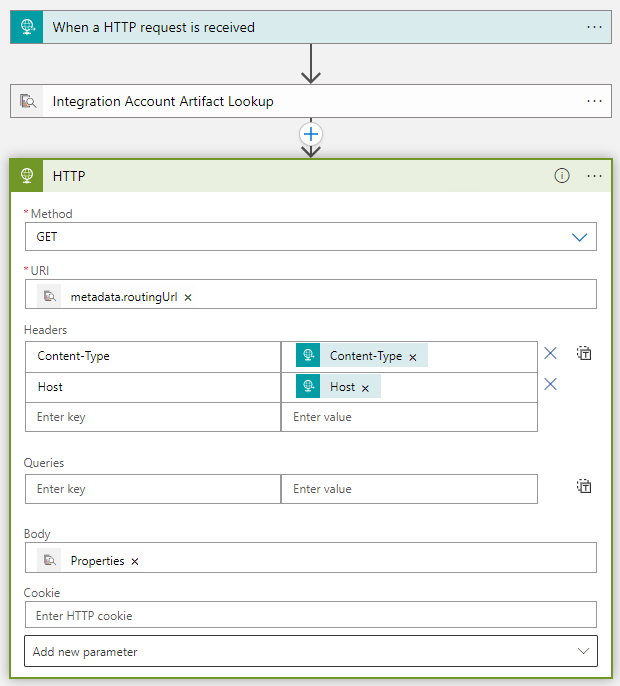管理 Azure Logic Apps 整合帳戶中的成品中繼資料
適用於:Azure Logic Apps (使用量)
您可以在整合帳戶中定義成品的自訂中繼資料,並在執行階段期間取得該中繼資料以供邏輯應用程式工作流程使用。 例如,您可以提供成品的中繼資料,例如合作夥伴、合約、結構描述和對應。 所有這些成品類型都會將中繼資料儲存為索引鍵/值組。
本操作指南說明如何將中繼資料新增至整合帳戶成品。 然後,您就可以使用工作流程中的動作,擷取及使用中繼資料值。
必要條件
Azure 帳戶和訂用帳戶。 若您沒有訂用帳戶,請建立一個免費帳戶。
包含要新增中繼資料之成品的整合帳戶。 成品可以是下列類型:
要使用成品中繼資料的邏輯應用程式工作流程。 請確定您的工作流程中至少有一個觸發程序 (例如要求或 HTTP 觸發程序),以及一個要用來處理成品中繼資料的動作。 本文中的範例會使用名為 When a HTTP request is received (收到 HTTP 要求時) 的要求觸發程序。
如需詳細資訊,請參閱下列文件:
將中繼資料新增到成品
在 Azure 入口網站,移至您的整合帳戶。
選取要新增中繼資料的成品,然後選取 [編輯]。

在 [編輯] 窗格中,輸入該成品的中繼資料詳細資料,然後選取 [確定]。 下列螢幕擷取畫面顯示三對中繼資料索引鍵/值組:

若要在整合帳戶的 JavaScript 物件標記法 (JSON) 定義中檢視此中繼資料,請選取 [編輯為 JSON],這會開啟 JSON 編輯器。

取得成品中繼資料
在 Azure 入口網站中,開啟已連結到整合帳戶的邏輯應用程式資源。
在邏輯應用程式的導覽功能表上,選取 [邏輯應用程式設計工具]。
在設計工具中,新增 [整合帳戶成品查閱] 動作以取得中繼資料。
在觸發程序或現有動作下,選取 [新增步驟]。
在 [選擇作業] 搜尋方塊底下,選取 [內建]。 在搜尋方塊中,輸入整合帳戶。
從動作清單中,選取名為 [整合帳戶成品查閱] 的動作。

針對您想要尋找的成品提供下列資訊:
屬性 必填 值 Description 成品類型 Yes [結構描述]、[對應]、[合作夥伴]、[合約],或自訂類型 想要取得的成品類型 成品名稱 Yes <artifact-name> 想要取得的成品名稱 此範例會依照下列步驟,取得交易夥伴成品的中繼資料:
[成品類型] 請選取 [合作夥伴]。
[成品名稱] 則在 [編輯] 方塊內按一下。 當動態內容清單出現時,從觸發程序中選取名稱輸出。

現在,新增您想要用來使用中繼資料的動作。 此範例會繼續執行內建的 HTTP 動作。

針對您希望 HTTP 動作使用的成品中繼資料,提供下列資訊。
例如,假設您想要取得之前新增的
routingUrl中繼資料。 以下是您可以指定的屬性值:屬性 必填 值 Description 範例值 方法 Yes <operation-to-run> 要在成品上執行的 HTTP 作業。 在此 HTTP 動作使用 GET 方法。 URI Yes <metadata-location> 您想要傳送傳出要求的端點。 請遵循下列步驟,參考所擷取成品的 routingUrl中繼資料值:
1.在 [URI] 方塊內按一下。
2.在動態內容清單開啟時,選取 [運算式]。
3.在運算式編輯器中,輸入類似以下範例的運算式:outputs('Integration_Account_Artifact_Lookup')['properties']['metadata']['routingUrl']
4.完成後,選取 [確定]。標題 No <header-values> 來自想要傳遞到 HTTP 動作之觸發程序的任何標頭輸出。 若要傳入觸發程序標頭的 Content-Type值,請遵循下列步驟以取得標頭下的第一個資料列:
1.在第一個資料行中,輸入Content-Type作為標頭名稱。
2.在第二個資料行中,使用運算式編輯器輸入下列運算式作為標頭值:triggeroutputs()['headers']['Content-Type']
若要傳入觸發程序標頭的Host值,請遵循下列步驟以取得標頭下的第二個資料列:
1.在第一個資料行中,輸入Host作為標頭名稱。
2.在第二個資料行中,使用運算式編輯器輸入下列運算式作為標頭值:triggeroutputs()['headers']['Host']本文 No <body-content> 您想要透過 HTTP 動作的 body屬性傳遞的任何其他內容。將成品的 properties值傳遞至 HTTP 動作:
1.在 [本文] 方塊內按一下,開啟動態內容清單。 如未出現屬性,請選取 [查看更多]。
2.從動態內容清單中,在 [整合帳戶成品查閱] 底下,選取 [屬性]。以下螢幕擷取畫面顯示範例值:

若要檢查您為 HTTP 動作提供的資訊,您可檢視工作流程的 JSON 定義。 在設計工具的工具列上,選取 [程式碼檢視]。
出現的工作流程 JSON 定義,如以下範例所示:

在程式碼檢視工具列上,選取 [設計工具]。
您在設計工具中輸入的任何運算式現在都會顯示為已解決。
